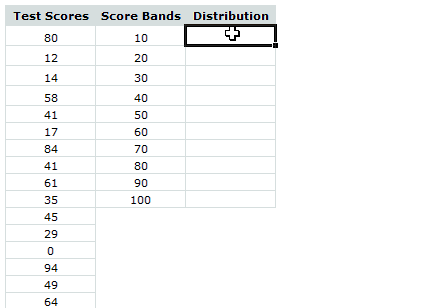Excel has very powerful formulas and add-ins for performing almost any kind of statistical analysis. Today we will learn how you can make a statistical distribution of test scores using excel.
This is a part of our spreadcheats series of posts where we aim to solve 30 common work related excel problems, one at a time. Read the earlier spreadcheats here.
Just follow the below 2 steps to create statistical distribution / frequency of any set of values using excel. Also, download the statistical distributions example workbook and play with it.
1. Define the bands for distribution
Assuming the test scores range from 0 to 100, you can define score bands like 10,20,30,40,50,60,70,80,90,100
2. Create a frequency formula and array enter it in to the spreadsheet
This part is even easier.
Assuming the test scores are in the range B6:B105 and bands are in the range c6:c15:
First select the cells D6:D16 (10 cells, 1 each for the frequency between 0-10, 10-20, 20-30, … 90-100) and then enter the FREQUENCY() formula.
What is FREQUENCY() formula?
FREQUENCY is an excel function that takes a range of values and a range of bands and tells you how the values are distributed in the bands. As you can guess, the formula returns an array of frequencies, so it must be entered in a bunch of cells together.
How do you do that? Simple, select a range of cells, enter the formula in the first cell by start typing =frequency… and when you are done, just press ctrl+shift+enter and excel takes care of the rest.
The formula we need to enter in our case is, =FREQUENCY(B6:B105,C6:C15) and when you press ctrl+shift+enter instead of just enter. The frequency values for each band will be entered in the corresponding row.
See the screencast below to understand it better.

That is all. So simple isn’ t it?
Download the statistical distributions example workbook and play with the formulas yourself.
More on statistics and excel:




















One Response to “How to export YouTube video comments to Excel file? – Free template + Power Query case study”
And I asked myself when i saw your Accouncement Video for the Give away: "Seriously, will Chandoo go manualy thru all his Videos and pick the winners?!". Great connection to the give away with this tutorial 🙂 !